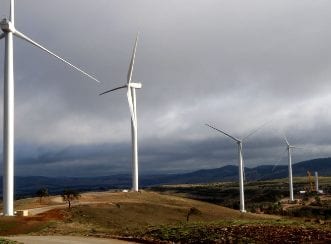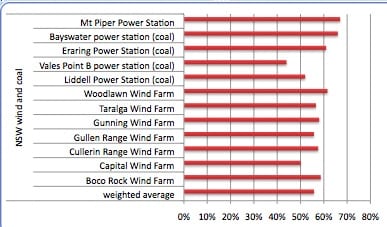Again, one's hope is that our educated urban elites (especially those of them trying to foist coal-fired power plants on our nation for private gain, even though it is not in the long-term national interest to do so) will draw inspiration from it - and realise that there is absolutely no need for despondency about the future of Ghana's power sector: if they put their thinking caps on for once and plan for a future when Ghana relies mainly on renewable sources for its electricity supply.
Please read on:
Big blow in NSW: Wind farms produce more than coal generators
By Giles Parkinson on 8 June 2016
Last month in South Australia, the state’s wind farms accounted for 49 per cent of all electricity demand, a useful contribution given the closure of the last coal fired generator.But in NSW the wind also blew at record levels, and the seven large scale wind farms delivered a record output, with a combined “capacity factor” of 56 per cent, more than two of the biggest coal generators in the state.

Indeed, the Woodlawn wind farm (pictured above) produced an astounding capacity factor of 62 per cent. Only two of the big five coal generators, the Mt Piper and Bayswater coal generators, produced at a higher capacity factor (67 and 66 per cent respectively).
 j
jThe data, compiled by Hugh Saddler from Pitt & Sherry highlight the changing nature of the energy system.
The emergence of rooftop solar and energy efficiency has capped the amount of electricity used, leaving a huge amount of over capacity in “base load” power, to the point where many coal generators, such as Vales Point (44 per cent) and Liddell (52 per cent), are operating at half their capacity – even if the overall share of coal power has not fallen.
The 48MW Woodlawn wind farm, located just outside of Canberra, is owned by Infigen Energy.
The top 12 wind farms in Australia, by capacity factor, in the month of May were:
Woodlawn (NSW, 48MW) 62%
Boco Rock (NSW) 59%
Cullerin Range (NSW) 58%
Gunning (NSW) 58%
Taralga (NSW) 57%
Hallet 1 + 2 (S.A.) 57%
Bald Hills (Vic) 56%
Mortons Lane (Vic) 55%
Mt Mercer (Vic) 54%
Woolnorth (Tas) 53%
North Brown Hill (S.A.) 52%
Snowtown South (S.A.) 52%''.
End of culled article by Giles Parkinson of RenewEconomy.
The question is: Is it beyond the capability of our nation to follow the example of New South Wales? The simple answer to that is: No, it is definitely not beyond the capacity of our nation to follow the example of New South Wales' power industry's renewables sector.
If our educated urban elites put their minds to it, they are perfectly capable of freeing Ghana from reliance on fossil fueled power plants, and transitioning to an era in which we rely on renewable sources for providing consumers throughout the nation, with electricity.
Could a consortium made up of some of the many high net worth members of the Executive Keep Fit Club of East Legon, for example, not put together a consortium made up of China's leading giant wind turbine makers, and the Shenzen Energy Group, to build the world's biggest wind farm, to produce 10,000 megawatts of electricity for Ghana?
And with the advances made in renewable energy storage technology, would our nation not be finally freed of the high-cost fossil fuel-fired power plants that produce killer-tariff electricity, if such a welcoming renewables sector development occurred?
Wth renewable energy storage now making it possible for electricity consumers to opt for off-grid energy independence, we must not be despondent about the future of Ghana's power sector.
We literally have a very bright future ahead - if our mostly-unimaginative political class will follow the example of nations that are planning for a future of being powered by 100% energy produced from renewable sources. There is absolutely no need for anyone in our country to be despondent about the future of Ghana's power sector.

No comments:
Post a Comment